iCallDroid spot User Manual

Getting Started
Thank you for purchasing iCallDroid spot (WiFi Router+ IP PBX).It is one cost-efficient yet easy-to-configure IP PBX in the market today.
Administrating a VoIP system can be a daunting task for administrators unfamiliar with VoIP. This guide is designed to help you plan and configure iCallDroid spot Voice over IP (VoIP) deployments.
Introduction
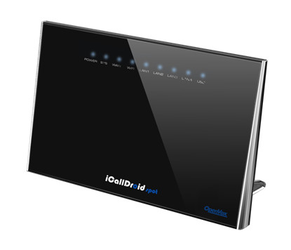
The iCallDroid spot (300M WiFi Router+ IP PBX) is the ideal system for small businesses and home offices requiring a pint-sized yet powerful on-premise wifi router IP PBX. It supports up to 4 concurrent calls with G.729 codec, but it might be less under high loading network transmission because of more CPU consumption.
The compact solid-state device supports 16 extensions and offers a wide range of IP PBX telephony features.
Keeping up with the demands of sustainability, the iCallDroid spot is based on a low-power, high performance MIPS processor, providing the complicated communication features including the hardest HD communication protocol, complete router features and QoS (Ensure the voice quality in a case the bandwidth is not enough).Meanwhile, the feature of one touch to deploy the phones makes the configuration of phones easy and enjoyable thing.
Packing list
1 unit iCallDroid spot
1 Piece Power Supply (12V,1A)
1 piece of 2-meter Network cables
1 Piece 8G MLC USB
Specification
MIPS Processor
64MB RAM/16MB FLASH
1xRJ45 10/100MB Ethernet port WAN
4xRJ45 Debug port
Button: Reset Button, One Touch to auto deploy
Power adapter: AC 100~240V input and DC 12V/1A output
Power consumption: 1.2-2.0W
Operating humidity: 10~95%
Operating temperature: 0~45°C
Hardware Setup
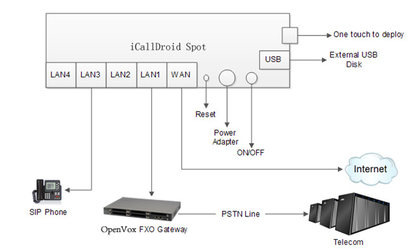
You may check the above picture to configurate.
Step 1: Connect the LAN port of iCallDroid spot with your corporate IP network. Before you connect the iCallDroid spot to the network, please check if your network can work normally.
Step 2: Plug in and open your browser to visit the web address: Http://192.168.1.1.
Make sure your PC IP address is 192.168.1.XXX.
(If you use IE6 and above, the prefix address http:// can’t be left out)
Now we access to the Wizard page.
Username: admin (By default)
Password: admin (By default)
Or you can find the WiFi SSID: WiFi Router and log in. Then visit the website: Http://192.168.1.1 .You can also choose the web language.

First Login to Wizard
This is your first time to log in, it will show Wizard Processing. It is simple and brief to deploy. In most cases, the default settings can be used for the rest of the configuration.
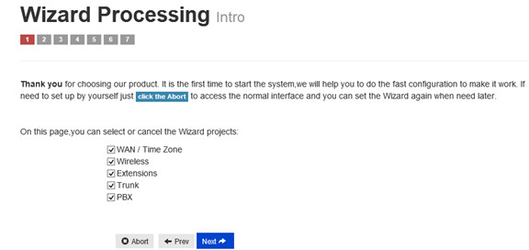
.
If you want to quit the Wizard, just Abort it.And if you want to access Wizard, just click the Wizad.
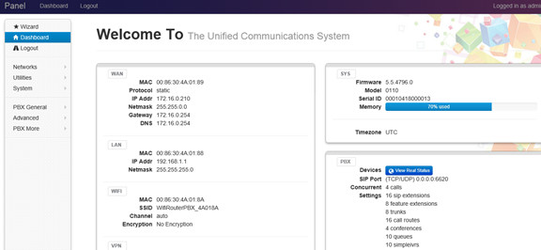
You can click Prev to return and Next to do the following steps.
On the Wizard page, you can set the WAN IP and Time Zone, Wireless, Extension, line provider and PBX.
You can select which part need to set then do the Next.
(You can also follow all the default settings and confirm)
Next is the WAN and Time Zone :
You can choose the Protocol Static IP, DHCP or PPPoE.
Static IP
Using a static IP address is the most reliable way to ensure your server IP address does not change. To find an IP address that is not in use on your network and will not be used for another client by the DHCP server or used by some other devices.
DHCP(Dynamic Host Configuration Protocol, DHCP)
PPPoE (Point to Point Protocol over Ethernet)
Fill out the account information from your telecom operator and Next.

Time Zone
You can set the local time here and it is important for generating accurate call reports for the system. And Time Frame will also analysis the system time to switch to the proper IVR.
If you select the incorrect time zone, or you move to a different time zone later, you can change it in the Wizard or in the Network-WAN/LAN/Time Zone.

Now we came to the Wireless page:
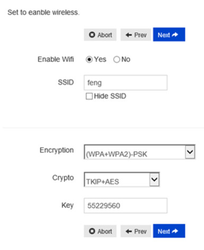
Here you can set the wireless option.
Enable Wifi and set the SSID (Service Set Identifier)
According to the tip in the black, choose your encryption, crypto and key.
Now we come to the Extension page.
The system has already auto generated 16 SIP extension by default.
(iCallDroid spot supports max 16 SIP extensions.)
You can set the extension number, password and the caller name.
If want to set the extensions quantity as you like, just amend this in Extension table.
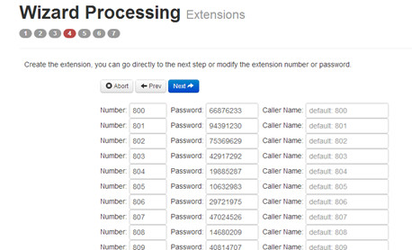
Next we come to Trunk Setting.
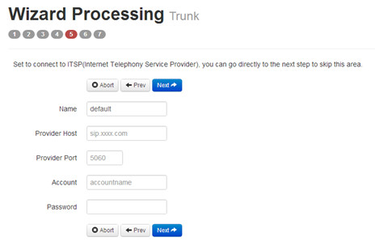
Set a SIP Trunk here. Fill out the Provider Host, account and password from your Internet Telephony Service Provider then one SIP Trunk will be built.
iCallDroid spot supports maximum 8 SIP trunks. If you want to build more, just do it in the Line Provider.
Next is PBX setting :
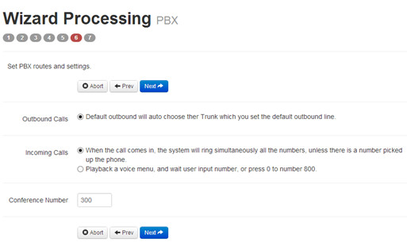
Here you can set how the system will deal with when make outbound calls or receive the inbound calls.
Outbound calls: Auto-select the Trunk which you set it as the default outbound line.
Incoming calls: Ring all the numbers when the call comes in or just into an IVR.
If want to set other routes, you can do it in Outbound Routes and Inbound Routes after the Wizard.
You can also set the conference number here. By default is 300.
Next well done! Just confirm to process.

Then the iCallDroid spot begin to configure. Now enjoy the HTML5 interface.
It will auto-restart the PBX and if you can’t see the page you can refresh it. If you amended the static IP address, re-visit the changed IP. Re-log in, you will see the dashboard of PBX iCallDroid spot.

OK. This is the first time to access the iCallDroid spot.
One touch to deploy*
Dashboard
You can see the status of WAN, LAN, VPN, Wifi, System and PBX in the dashboard.
Usually you will find the information you need here.
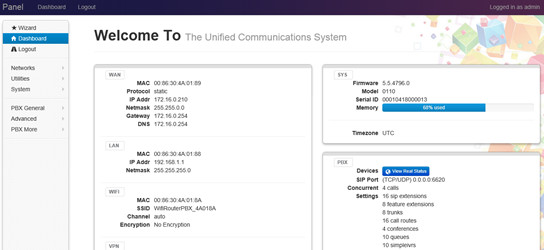
Wifi Router
Networks

Here as the same as the setting in the Wizard.
You can change the WAN Port here and also Time Zone.
WAN/LAN/TimeZone
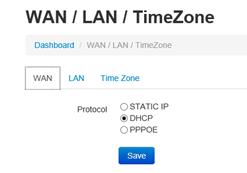
Here you can set the WAN port.
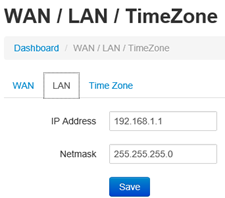
Here you can set the LAN port.
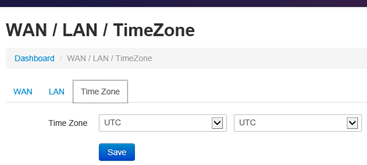
Here you can set the time Zone.
Wireless
Here is the wireless setting. Just as it in the Wizard.
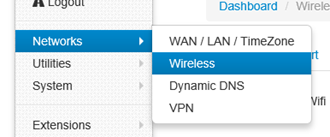
The general setting is the same as it in the Wizard.
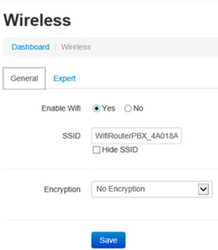
You will have this option as in Expert below:
Channel, HT Bandwidth, Wireless Mode, Tx Power, WMM (Wi-Fi Multimedia)
WMM( Wi-Fi Multimedia): is a Wi-Fi Alliance interoperability certification, based on the IEEE 802.11e standard. It provides basic Quality of service (QoS) features to IEEE 802.11 networks. WMM prioritizes traffic according to four Access Categories (AC) – voice, video, best effort, and background. However, it does not provide guaranteed throughput. It is suitable for simple applications that require QoS, such as Voice over IP (VoIP) on Wi-Fi phones.

Dynamic DNS
Here you can set the Dynamic DNS.
Dynamic DNS or DDNS is a method of updating, in real time, a Domain Name System (DNS) to point to a changing IP address on the Internet. This is used to provide a persistent domain name for a resource that may change location on the network.
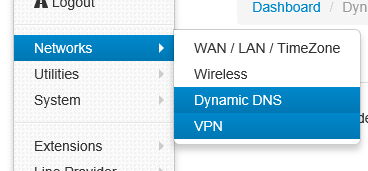
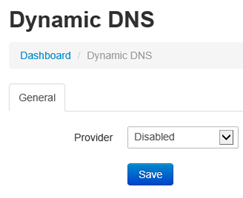
Here you can choose two free dynamic domain web to apply the account.
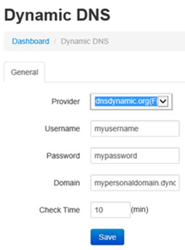
VPN
Virtual Private Network
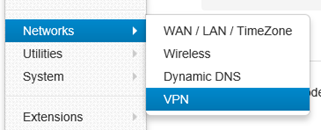
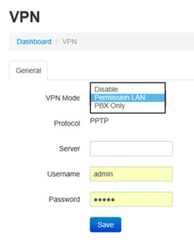
If you choose Disable that means the VPN doesn’t work.
Permission LAN means all the data from the LAN will go via VPN.
PBX Only means only the PBX data (VoIP) will go via VPN.
Utilities
DHCP Server
You can check the devices in the network here and also set the server.
You can enable DHCP server or not.
You can set where Client IP Start from and Max clients.
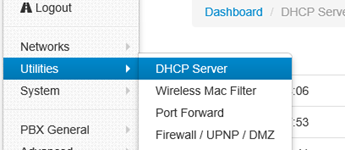

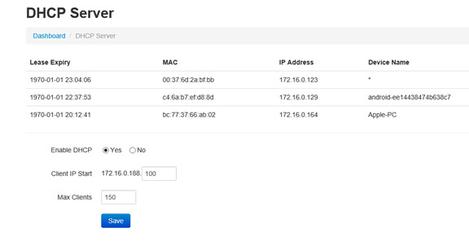
Wireless Mac Filter
You can set the white list and black list to manage the devices which want to visit the network.
All the devices in white list are permitted to visit the network.
While if in the black list, no device can visit the network.
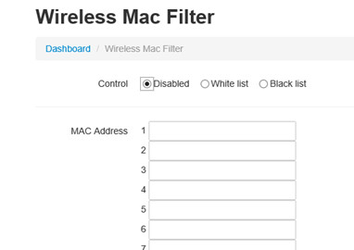
Port Forward
Set the IP address, Mac, port from the source and destination, choose the protocol and enable.
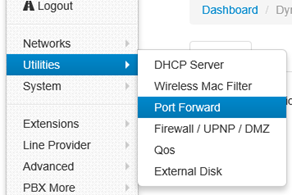
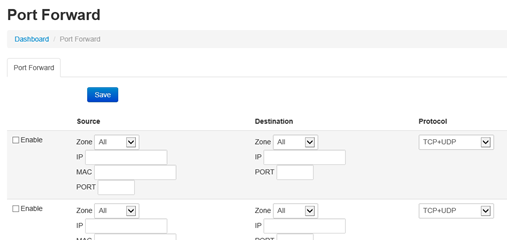
Firewall/UPNP/DMZ
UPN (Universal Plug and Play)
DMZ (Demilitarized zone)
Here you can set the DMZ PC IP, if enable the UPNP&NAT-PMP and WAN Ping response, WAN web access, WAN Ftp and WAN PBX.

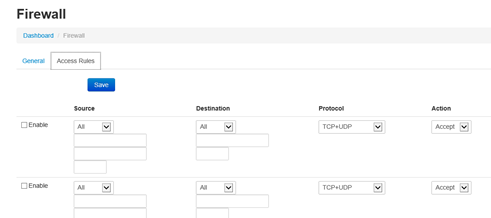
Here you can set the Access Rules.
QoS
Quality of service. The system enables QoS by default.
It ensures the voice quality in a case the bandwidth is not enough.
You can also set the WAN download/upload bandwidth.
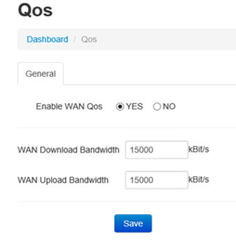
Disk and Sharing
Here you can insert a USB device to record the calls and voicemail.
And also set the file sharing.
It supports FAT32, EXT4 or based the MLC USB disk.
We recommend using the USB device with power adaptor alone.
Insert one USB. Please remember to click the button “Enbale” to record in the Disk.

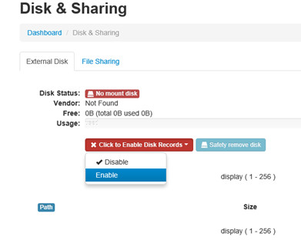
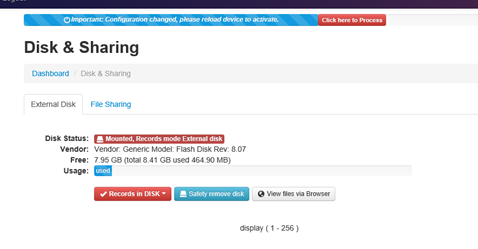
Now you can find the call recording option in the Extensions-Extension-Expert. Recording file will be saving on USB external disk memory only.
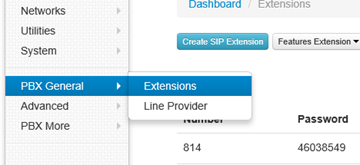
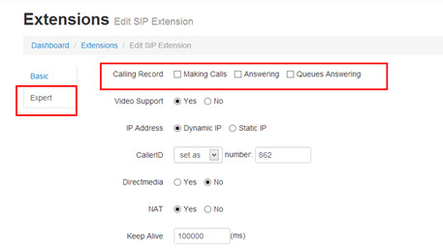
You can also check the PBX data-Extensions to find the record file.
You can download and delete the files.
Or you can check them in FTP as below.
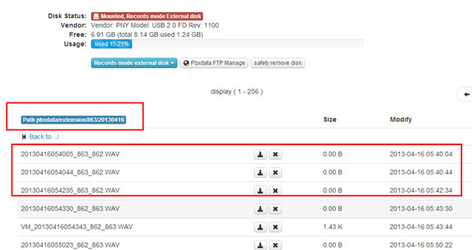
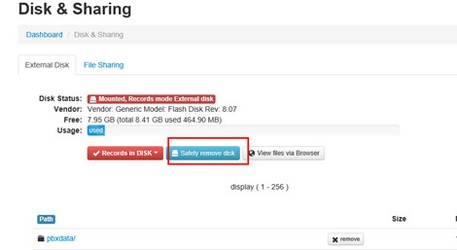
When you want to extract the USB, close all the files related to USB before click the safety remove disk and wait around 1-3 seconds. Then it will be ok as below.
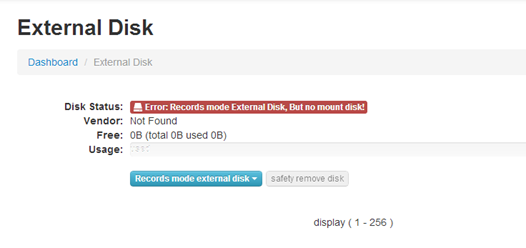
File Sharing
You can treat the iCallDroid spot as a file sharing server now.
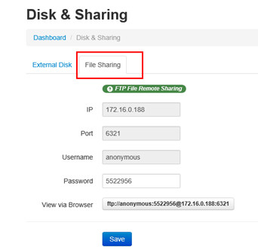
Use the FTP software to connect the Server and you can enjoy the file sharing.
The password is empty by default. You can log in the FTP anonymously.
IP, Port and the username can’t be amended.
System

Real Status
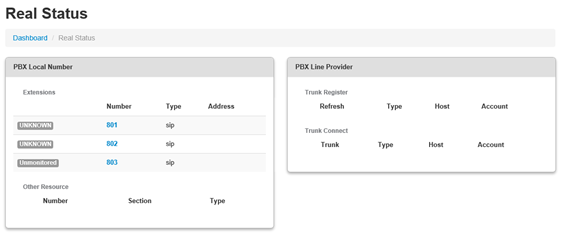
Here you can see the PBX extension status, SIP Trunk status and other Resource in the later.
Call Details Report
Here you will find the call detail report.

Logs View
You can find the system logs here. It is very convenient to check any problem.
Click to Refresh, it will show the latest log.

Admin User
You can amend the sign-in password here.
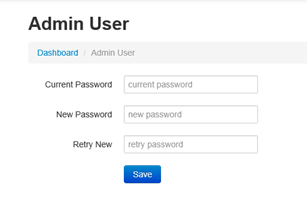
Reboot
You can reboot the system here.
Also you can reload Networks, Wifi, Firewall, PBX.
Reset Factory
Factory Mode: Input your password to reset your device.(Admin by default)
VoIP
PBX General
Here you can set the extensions and line provider.
Extensions
SIP (Session Initiation Protocol) [RFC 3261, 3262, 3263, 3264, and 3265]
Create the SIP extensions: Set the number (not less than 3 digits), password (not less than 8 digits) and caller name if need.
No-Answer Option: When nobody answers after ringing. It will auto hang up, go to Voice Mail or Forward.(use Voice Mail need to insert the USB disk)
You can also set the ring time as below, after the ring time, it will execute the option.
Extension Expert part:
For the Expert use, you can set the Video Support, IP address and so on
Video Support: Choose Yes or No.
IP address: Dynamic IP or Static IP. If you choose the Static IP, just fill your IP address and make sure it is the same with this device.
Call ID: You can use the extension number (Default) or use this number you set yourself.
Direct Media: The default is No.
If you choose yes, it will not transfer the voice data.
Nat: Please see the glossary
Keep Alive: Keep in touch with the contacted device.
DTMF Mode refers to the types of tones a phone can send and receive. Refer to your phone’s user manual to find the type of DTMF tones used by your particular phone. Unless you are certain this setting needs to be changed, leave it at the default value, rfc2833.
Codec Priority: You can choose the codec priority here.
Press Create and Click the Reload in the Red Bar. One extension is well done. It will need the SIP account and password when you set SIP phone. So please remember the SIP account and password here.
If need to modify the setting or have a view, just click the edit button. To remove an extension from your system permanently, click the Delete button.
Click the Record, you can go to check the call record directly.
Follow Me
One of the feature extensions is Follow Me.
If you have more than one number, when a call comes in, the system will ring your numbers one by one until someone answered.
You can set the detail in basic and expert. The expert is not available now.
You can set the order of the extensions number to ring.
You can also set to forward to the external number as below.
Ring Group
When the call comes in, all the extensions will ring simultaneously until someone to pick it up. The setting is similar to Follow me.
And here you can also view the extension status.
Click it and the page will turn to the real status page.
And click the back to previous page.
Line Provider
You can set the line provider here. Sip Register and Sip Direct.
After you finished the register information, remember to tick the Outbound Calls-Default outbound calls
.
SIP Register
SIP Register: Use a SIP account and password and Provider IP address to register to the ITSP.
You can also choose the system process rule when there is incoming call.
Default to answer: You can set the default configuration in the PBX More Option.
Set DID number: you can set the DID number here. When you create the Queue or Conference and you can set the number here for the caller to go into.
Specific who to answer: Specific the certain extension to answer.
Finally you can tick the default outbound line or the outbound routes.
Call with prefix number: Set this number when you make a call with this prefix outbound,
It will auto go via this line. In a word, it is convenient for you to change the line when make calls between default line and another outbound line.
You can also view this setting in the Wizard.
SIP Direct
You can create the SIP direct.
Here we use the 2 iCallDroid spot as example:
First check the SIP port : it is 6620.
Then input another IP address to create SIP direct. Make sure the port is the same and there is no two extensions with the same number. OK, done.
Advanced
Outbound Routes
Outbound Routes for extensions dialing local / outside number.
When dialing, the top-down one by one checking rules, if matched will be execute and end route.
When dialing, not matched or no rule will try to execute ‘Default Rule’ settings.
You can choose the default rule. In most cases, the default settings can be used for the rest of the configuration.
Default Rules:
[Smart]Automatically try local number, if not matched then try to select [efault Outbound] and call out.
[Local] Automatically try local number
[Disable]End the call
Default Outbound: You can choose the default outbound line here.
Create New Rule first:
Now you can set the outbound routes.
You can refer the tips. Set the rules to match caller ID or match the called party ID (Callee), then set the relevant executive rules: we can format caller Id/ callee ID .If don’t need, leave NULL.
Rules are different as many as you think.
Examples are in the routes manual.
After you create them, you can modify the order of rules by dragging and click ‘Save Rules New order’ to confirm. And you can also edit and delete the rules.
Inbound Routes
Inbound Routes for Line provider dialing local number / transfer to other line provider.
Create a new rule as below, you can create the new rules for the incoming calls.
The rule setting is similar to outbound routes. You can refer the tips. Below is the diagram.
After you set several rules, you can edit or delete them.
You can also modify the order of rules by dragging and click ‘Save Rules New order’ to confirm.
You can modify the order of rules by dragging and click ‘Save Rules New order’ to confirm.
When a call comes in, the system will prior process ‘Auto Find Extension’, next check the rules one by one from top to down, finally perform ‘Default Rule’.
Conference
Set the conference number as you like and choose if you want to enable to announce the Join/leave by system or enable to playback the music when only one person in it.
After you set, you can make a call to the conference number via the extension.
Queues
Select this type if the extension will queue callers to speak with a representative. Call queues are often used to dial into a particular department or group; for example, the extension for the accounting department might be a call queue. You can customize your call queues in the extension setup process.
Now for example, we create a Queue, we add 802 and 800 into our queue.
You can also set the service strategy: Ring all, Radom, Memory.
You can also set the member rings time and when pick up, how you want to deal with.
Simple IVR
Here we can set the IVR (Voice menu)
For example, we set one IVR number 333, choose the playback file-Welcome, and choose that press 0 to transfer to 800 and press 1 to transfer to 801.Create the new IVR.
Time Frame: You need to set Time Frame area then come back to choose.
Expert: You can set the mode when user input the invalid number.
Input Max Digit Len: For example, if you input 3 means if you press only one number when you access to the IVR, you need to press that number and # to call directly. Otherwise need to wait the Max Time.
Max Time: the waiting time to connect someone.
Input Retry: For example, if you input continuous two time wrong number, the system will automatically transfer to another number you input.
After fill out the information you need, just to click create new IVR and reboot.
Time Frames
In most cases, it is useful to create an IVR to run in the time of working days, holidays, nights and so on for the companies to handle with the business calls. This we called Time Frames.
As the above, we create one set working time and click “add”. Now we can come back to the simple IVR- time frame – to set it.
The IVR format is GSM file. You can upload the sounds file in Sounds File.
If all the parameters are zero, it means to ignore this time frame.
(Advanced-Simple IVR)
OK. When during the working time you set, all the incoming calls will transfer to 801.
PBX More
Sound Files
By default, the file name is unmodified when you add a new sound.
It can be used as the Simple IVR’s file.
File Ext name/ file size: Unmodified.
Upload file: you can choose the way to upload the file.
Web upload: Only support GSM file.
When you input one extension number, it will record automatically.
When you upload a sound file, you can listen, edit and delete.
Option
PBX General:
Outbound and internal ring time: you can input the time of ring you like.
Extension dialing route: you can set the dialing route here as well as the Extension-Dialing Route
Trunk Dialing route: you can also find the setting in Line provider-Dial-in Route
IVR MAX TRY: For example, if we input 2 means the system will automatically quit when the IVR playback for twice.
Call Notification: When Make call to Extensions (SIP Ring Group Follow Me) or to Queues (Extensions Answered) or to IVR(Extensions Answered), PBX will send notification to url.
Hot Keys
You can set the call pick up prefix number to pick the extension.
You can’t set “#” as the prefix as it is used by the system.
Set the voice mail playback number to get your voice mail and listen.
Dial the number directly on your phone to listen.
SIP Protocol
Anonymous Call In
UDP Bind Port: by default is 6020
Please note you should modify this port when you set the extension port is 5060.
Max Register Expiry
Min Register Expiry
Default Register Expiry
Progress Mode
T.38 UDPTL
You can also set the Jitter Buffer option. Default is enabling Jitter Buffer.
It will help to protect and keep the voice with good quality.
SIP Behind NAT
This experimental feature is that when a PBX as a SIP server behind Nat, SIP Nats allows your SIP phone and IADs to register into PBX. And it needs the firewall and router’s support.
Voicemail
Say Date time if choose yes, it will read the call record date.
Say caller ID: if choose yes, it will read the caller ID.
Glossary
ATA (Analog Telephony Adapter)
A device used to connect one or more standard analog telephones to a digital and/or non-standard telephone system such as a Voice Over IP based network.
DID (Direct Inward Dial)
A feature offered by telephone companies for use with their customers’ private branch exchange (PBX) systems. In DID service, the telephone company provides one or more trunk lines to the customer for connection to the customer’s PBX and allocates a range of telephone numbers to this line (or group of lines) and forwards all calls to such numbers via the trunk. As calls are presented to the PBX, the dialed destination number (DNIS) is transmitted, usually partially (e.g., last four digits), so that the PBX can route the call directly to the desired telephone extension within the organization without the need for an operator or attendant.
DID numbers are assigned to a communications gateway connected by a trunk to the public switched telephone network (PSTN) and the VoIP network. The gateway routes and translates calls between the two networks for the VoIP user. Calls originating in the VoIP network will appear to users on the PSTN as originating from one of the assigned DID numbers.
DNS (domain name system)
The Internet’s name/address resolution service that translates alphabetic domain names into numeric IP addresses. For example, the domain name www.pbx.com might translate to 198.105.232.4. If a computer cannot access DNS, the user’s web browser will not be able to find web sites and the user will not be able to receive or send email. The DNS system consists of three components: DNS data,name servers, and Internet protocols for getting the data from the servers.
Domain name server
A computer that runs a program that converts a fully qualified domain name (FQDN) into its numeric
IP address and vice versa.
DTMF (Dual-Tone Multi-Frequency)
The signal that is generated when a user presses the touch keys of an ordinary telephone. Also known as “Touchtone,” DTMF has essentially replaced pulse dialling. When a user presses touch keys, two tones of specific frequencies are generated (one from a high-frequency group and the other from a lowfrequency
group), so it’s impossible for the voice to imitate the tones.
FTP (File Transfer Protocol)
A standard Internet protocol used to upload and download files between computers that are connected to the Internet. FTP uses the Internet’s TCP/IP protocols as does HTTP, which transfers displayable Web pages and related files, and SMTP, which transfers e-mail.
GSM (Global System for Mobile communication)
A wireless telephone standard in Europe and other parts of the world.GSM uses a variation of time division multiple access (TDMA), which is the most widely used of the three digital wireless telephony technologies (TDMA, GSM, and CDMA). GSM digitizes and compresses data, then sends it down a channel with two other streams of user data, each in its own time slot. It operates at either the 900 MHz or 1800 MHz frequency band.
IP-PBX (Internet Protocol Private Branch Exchange)
A telephone switch (see “PBX”) located on a customer’s premises that utilize VoIP to manage and deliver calls.
ITSP (Internet Telephone Service Provider)
A company that offers an Internet data service for making telephone calls using VoIP. Most ITSPs use SIP, H.323, or IAX for transmitting telephone calls as IP data packets. Customers may use VoIP phones or traditional telephones with an analog telephony adapter (ATA).
ITU (International Telecommunication Union)
A telecommunications standards body that is guided by the United Nations. It was founded as the International Telegraph Union in Paris on May 17, 1865. The ITU acts as the global focal point for governments and the private sector in developing networks and services and is comprised of more than 185 countries and produces over 200 standards recommendations annually in the areas of information
technology, consumer electronics, broadcasting, and multimedia communications.
IVR (Interactive Voice Response)
A telephone technology that allows a caller to respond to configured voice menus through voice and
touch tone. The IVR system responds with pre-recorded audio to further direct callers on how to proceed.
LAN (Local Area Network)
A computer network covering a small physical area, like a home, office, or small group of buildings, such as a school, or an office park. LANs are connected primarily through Ethernet and can be connected to other LANs over any distance via telephone lines and radio waves. LANs have a high data transfer rate and are not very expensive to set up. See also “WAN.”
MAC (Media Access Control) address
A hardware address that uniquely identifies most network adapters or network interface cards (NICs) by the manufacturer for identification. The manufacturer’s registered identification number is usually part of the MAC address if it was assigned by the manufacturer. The MAC address is used by the Media Access Control protocol sub-layer of the Data-Link Layer (DLC) of telecommunication protocols.
MIPS (million instructions per second)
An old method for measuring a computer’s speed and power and, by implication, for determining the amount of work a computer can do. It measures the approximate number of machine instructions the computer can execute in 1 second (i.e., it measures CPU speed). Because there are so many variables with computer performance (e.g., varying amounts of time for different instructions, importance of I/O speed, etc.), MIPS ratings are not used that often anymore. However, a MIPS rating can give you a general idea of a computer’s speed.
NAT (Network Address Translation or Network Address Translator)
The method for translating an IP address used within one network to a different IP address known within another network (one network is designated the inside network and the other is the outside network). NAT allows as a router, for example, to act as an agent between the public network (e.g., the Internet) and a private network (i.e., a local network), which means that a single, unique IP address can represent an entire group of computers.
PBX (Private Branch exchange)
A telephone exchange that serves a particular business or office, as opposed to one that is owned by a common carrier or telephone company and is used by many businesses or the general public. Users of the PBX share a certain number of outside lines for making telephone calls external to the PBX.PBXs have evolved over time, beginning as a manual switchboard or attendant console that was operated by a telephone operator (circuit switching) to the modern IP PBX. See also “IP PBX.”
PSTN (Public Switched Telephone Network)
The network of the world’s public circuit-switched telephone networks. Originally a network of fixed line analog telephone systems, the PSTN is now almost entirely digital in its core and includes mobile as well as fixed (plain old telephone service, POTS) telephones. The PSTN is largely governed by technical standards created by the ITU-T, and uses E.163/E.164 telephone numbers for addressing.
Proxy Server
A server (a computer system or an application program) that acts as an intermediary for requests from clients seeking resources from other servers. The VoIP proxy server is used in a DMZ of a company’s secure internal communication network and receives VoIP control messages and VoIP media streams.
Using the MAC address and source IP address contained in the control message, the proxy server pushes a policy change to the internal network’s external firewall to open call control protocol ports and Real Time Protocol (RTP) ports only for packets from the source IP address. The VoIP proxy server hides the company’s internal network address and directs incoming VoIP packets to an IP-PBX connected to the company’s internal network.
RAM (Random Access Memory)
A form of computer data storage that allows stored data to be accessed in any order (i.e., “random access”).
RAM is used by a computer’s operating system, application programs, and currently used data, so that they can quickly be reached by the computer’s processor. RAM is quickly readable and writeable compared to other kinds of computer storage (e.g., the hard disk, floppy disk, and CD-ROM);However, data in RAM remains only as long as the computer is running. Once the computer has been turned off, RAM loses its data. When the computer is turned on again, the operating system and other files are once again loaded into RAM.
Router
A device for connecting one or more computers to other computers, networked devices, or to other networks. Compared to hubs and switches (which are also connecting types of devices), a router is the smartest and most complicated of the three. Routers can be programmed to understand and route the data its being asked to handle. Configuration is done through a user interface. Larger routers are capable of being programmed to communicate with other routers to determine the best method of getting network traffic from point A to point B. Hubs work at the data link and network layers (layers
2 and 3) of the OSI model.
SIP (Session Initiation Protocol) [RFC 3261, 3262, 3263, 3264, and 3265]
A signalling protocol for initiating and terminating an interactive user session that involves multimedia elements such as video, voice, chat, gaming, and virtual reality (it is used mainly for voice and video calls over the Internet or data networks).
SIP Trunk
A service offered by an ITSP that allows businesses that have a PBX for their internal calls to use VoIP to go outside the enterprise network by using the same connection as the Internet connection. Before SIP trunks can be deployed, a business must have a PBX with a SIP-enabled trunk side, an enterprise edge device that understands SIP, and an ITSP. See “ITSP.”
Soft-switch (software switch)
A term used to describe the software that is used to bridge a public switched telephone network (PSTN) and VoIP. This is done by separating the call control functions of a phone call from the media gateway (transport layer). The soft-switch is typically used to control connections at the junction point between circuit and packet networks.
UDP (User Datagram Protocol) [RFC 768]
A communications protocol that offers a limited amount of service when messages are exchanged between computers in a network that is using the Internet Protocol (IP). UDP merely performs IP traffic demultiplexing based on UDP port numbers, after which it provides a checksum that can be used by end systems to determine whether the datagrams received were corrupted by the network.
WAN (Wide Area Network)
A computer network that covers a broad area (e.g., any network that links across metropolitan, regional, or national boundaries). WANs are similar to the Internet in that they are not owned by a single organization. They exist under collective or distributed ownership and management. For WAN connectivity over the longer distances, ATM, frame relay, and X.25 are used. Computers connected to
a WAN can be connected via the telephone system, leased lines, or satellites. WANs have a lower data transfer rate when compared to LANs. See also “LAN.”
